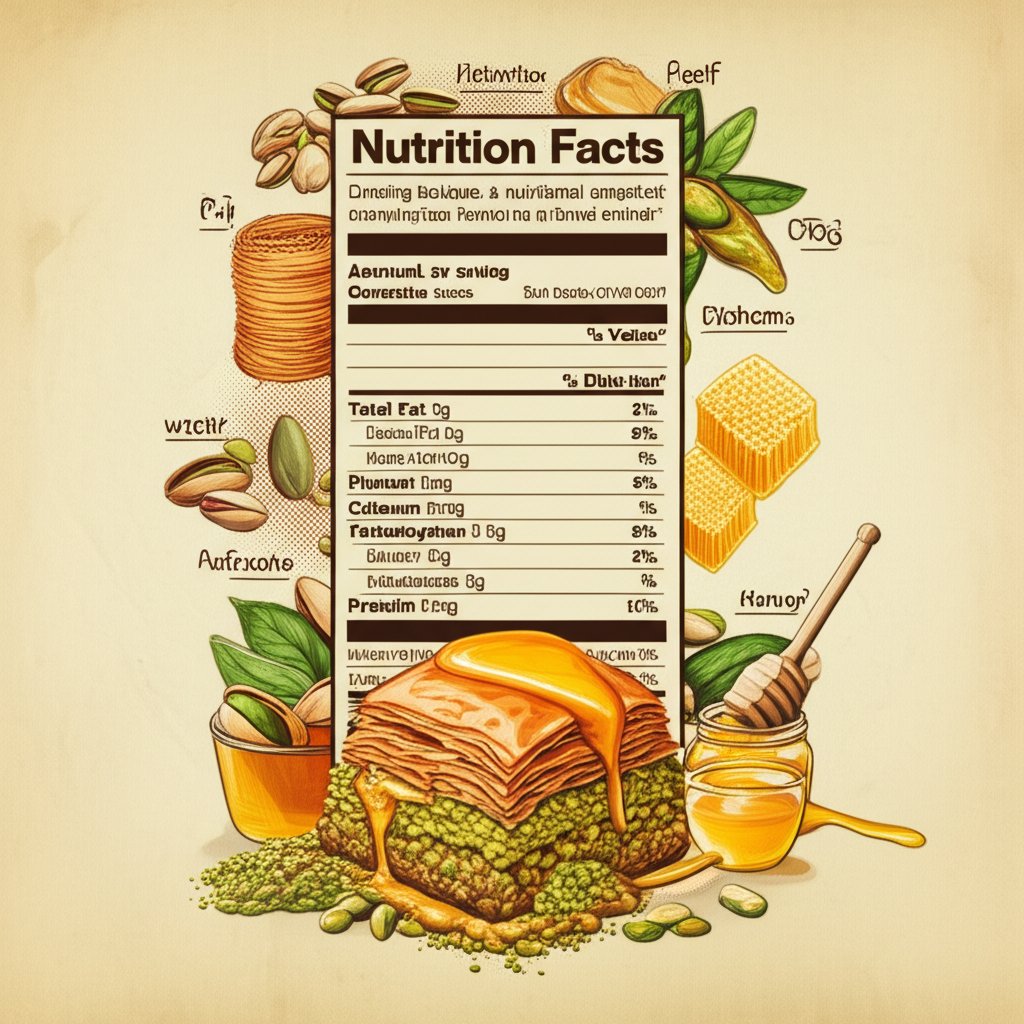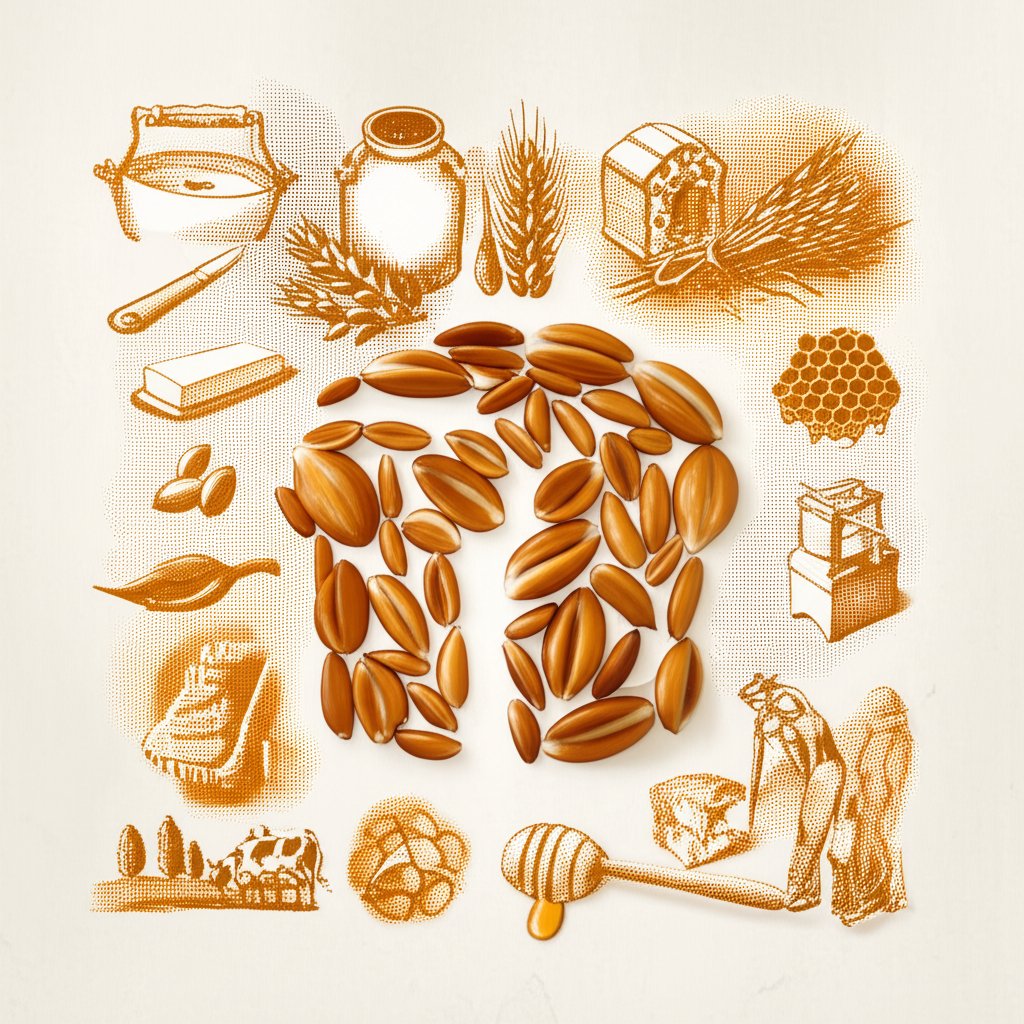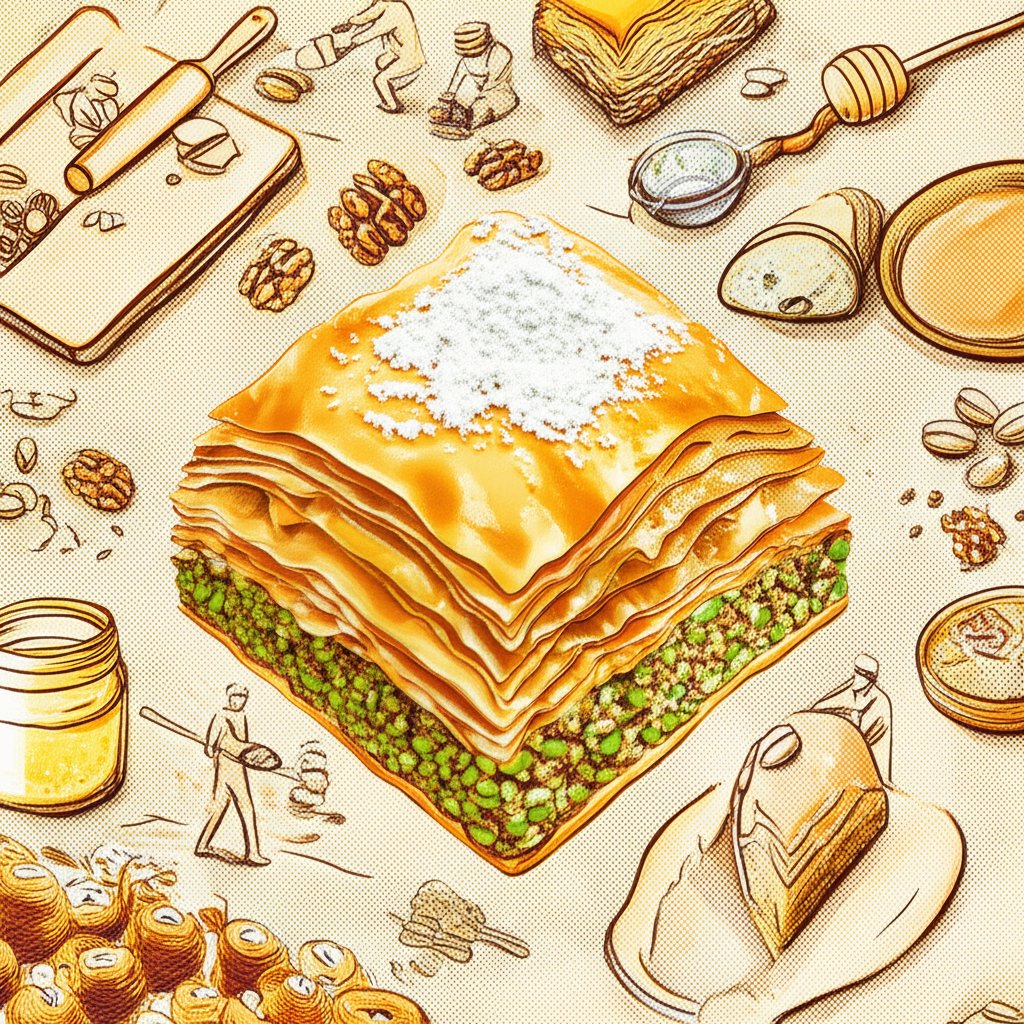Craving something sweet and flaky? Baklava’s intricate layers of pastry and nutty filling make it an irresistible treat, but understanding the baklava nutrition facts is key to enjoying it mindfully. This guide will help you navigate baklava’s nutritional profile so you can indulge without the guilt.
At a glance:
- Uncover the calorie count and macro breakdown of a typical serving of baklava.
- Learn how baklava’s ingredients (nuts, butter, syrup) contribute to its nutritional value.
- Discover healthier baklava alternatives and portion control tips.
- Address common misconceptions about baklava’s impact on your health.
- Find a way to fit baklava into a balanced diet without derailing your health goals.
Decoding Baklava: A Nutritional Snapshot
Baklava is a dessert made from layers of filo pastry, filled with chopped nuts, and sweetened with syrup or honey. Its rich taste comes with a significant nutritional punch, which isn’t necessarily a bad thing, as long as you’re aware of it.
Here’s a general breakdown of the baklava nutrition facts for a single piece (approximately 2 ounces or 57 grams):
- Calories: 220-300
- Total Fat: 12-18g (often high in saturated fat due to butter)
- Saturated Fat: 7-11g
- Cholesterol: 30-50mg
- Sodium: 50-100mg
- Total Carbohydrates: 25-35g
- Sugars: 15-25g
- Protein: 3-5g
Keep in mind these numbers can vary depending on the recipe, the ratio of nuts to pastry, and the type of sweetener used.
The Good, The Sweet, and The Buttery: Ingredient Breakdown
To truly understand baklava nutrition facts, let’s look at its key ingredients:
- Filo Pastry: Thin, unleavened dough, relatively low in calories and fat on its own, but its multiple layers contribute to the overall calorie count.
- Nuts (Walnuts, Pistachios, Almonds): A good source of healthy fats, protein, and fiber. They also provide essential vitamins and minerals. Walnuts, in particular, are rich in omega-3 fatty acids.
- Butter or Oil: Often used generously to brush the filo layers. Butter adds a rich flavor but is high in saturated fat. Some recipes use oil, which can be a healthier alternative depending on the type of oil.
- Sweetener (Sugar Syrup, Honey): Provides sweetness but also a significant amount of sugar and calories. Honey offers some antioxidants but is still primarily sugar.
Each ingredient contributes its own set of nutrients, but the overall impact largely depends on the quantities used.
Making Smart Choices: How to Enjoy Baklava Mindfully

Love baklava but want to keep your health in check? Here’s your strategy:
- Portion Control is Paramount: A single piece is often enough to satisfy your sweet craving. Resist the urge to have seconds (or thirds!). Consider cutting a piece in half and saving the rest for later.
- Look for Healthier Options: Some bakeries offer baklava made with less butter or healthier oils. Also, some use natural sweeteners or less sugar.
- Homemade is Best (Control Freak Edition): When you bake it yourself, you can swap out butter for olive oil or avocado oil. You can also use honey or maple syrup instead of white sugar.
- Pair with Nutrient-Rich Foods: Instead of having baklava as a standalone snack, enjoy it after a balanced meal. This helps regulate blood sugar levels and reduces the likelihood of overeating.
- Limit Frequency: Make baklava an occasional treat rather than a daily indulgence.
Example: Sarah loves baklava but is watching her weight. She decided to bake low-sugar baklava at home using half the butter and replaced the other half with olive oil. She limited herself to one small square after dinner twice a month.
Baklava vs. Alternatives: Making Informed Choices
How does baklava stack up against other sweet treats?
| Dessert | Calories (per serving) | Sugar (g) | Fat (g) | Notes |
|---|---|---|---|---|
| Baklava (2 oz) | 250 | 20 | 15 | High in saturated fat, but contains nuts with healthy fats. |
| Chocolate Cake | 350 | 30 | 20 | Often higher in calories and sugar, less nutritional value. |
| Apple Pie | 300 | 25 | 12 | Can be a good source of fiber if made with whole wheat crust, but high in sugar. |
| Fruit Salad | 100 | 15 | 0 | Naturally sweet and packed with vitamins and minerals; a much healthier alternative. |
| As you can see, while baklava has some redeeming qualities (nuts!), it’s important to be mindful of its calorie and sugar content compared to other options. If you’re looking for a dessert that won’t derail your diet, fruit salad is a clear winner. |
Reframing the Treat: A Step-by-Step Action Plan
Here’s an immediate plan to enjoy Baklava while staying healthy:
- Assess Your Current Intake: How often do you eat baklava? How much do you usually consume? Be honest with yourself.
- Set Realistic Goals: Decide how frequently you want to enjoy baklava and stick to that limit. Maybe once a week, maybe once a month.
- Explore Healthier Recipes: Look for recipes that use less butter or sugar, or try making your own baklava at home.
- Practice Mindful Eating: Savor each bite and pay attention to your body’s cues. Stop when you’re satisfied, not stuffed.
- Track Your Progress: Keep a food journal or use a tracking app to monitor your overall calorie and sugar intake.
An Arizona Green Tea Pairing? Understanding Balance

Enjoying treats like baklava can absolutely be part of a healthy lifestyle. It’s about finding balance. Pairing a treat like baklava with a better-for-you beverage is one small way to approach that balance. For example, you might consider having a small portion of baklava alongside a refreshing glass of Arizona Green Tea. If you’re curious about the nutritional breakdown of Arizona Green Tea, you can learn more here: Arizona Green Tea Ingredients.
Quick Answers: Common Baklava Questions
Q: Is baklava “healthy”?
A: Not in the traditional sense. It’s high in calories, sugar, and saturated fat. However, the nuts do provide healthy fats, protein, and fiber. It’s all about moderation.
Q: Can I eat baklava if I have diabetes?
A: Consult your doctor. Due to the high sugar content, baklava can significantly impact blood sugar levels. If you do choose to eat it, do so in very small portions and monitor your blood sugar closely.
Q: Is homemade baklava healthier than store-bought?
A: Potentially, yes. When you make it at home, you have control over the ingredients and can use healthier alternatives like olive oil, honey, or less sugar.
Q: Can I freeze baklava?
A: Yes! Freezing baklava can help you control portion sizes and prevent overeating. Wrap it tightly to prevent freezer burn.
Enjoying Wisely: Your Baklava Decision Tree
Here’s a quick guide to help you make informed decisions about eating baklava:
- Craving Baklava?
- Yes:
- Am I hungry or just craving?
- Hungry: Eat a small portion (1 piece) after a balanced meal.
- Just craving: Drink a glass of water or have a healthy snack (fruit, yogurt) first. If the craving persists, have a small portion.
- Can I choose a healthier option (homemade, less sugar)?
- Yes: Opt for the healthier option.
- No: Practice mindful eating and savor each bite.
- Have I had baklava recently?
- Yes: Consider waiting a few days before having it again.
- No: Enjoy in moderation.
- No: Choose a different dessert.
Satisfy Your Sweet Tooth Without Derailing Your Health
Baklava doesn’t have to be off-limits. By understanding the baklava nutrition facts, practicing portion control, and making informed choices, you can enjoy this delicious treat as part of a balanced diet and lifestyle. It’s about making conscious decisions and enjoying everything in moderation. Treat yourself wisely!
- Bento Tray Revolutionizes Organized Meal Transport and Presentation - December 10, 2025
- Meal Plans for Busy Schedules That Make Healthy Eating Easy - December 10, 2025
- Where to Buy Bento Boxes for Healthy, Organized Meals - December 9, 2025










